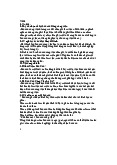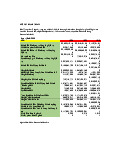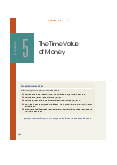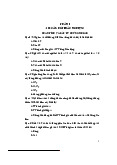



















Preview text:
See discussions, stats, and author profiles for this publication at: https://www.researchgate.net/publication/335797239
Creativity and Innovation What the Research Says FOSTERING GLOBAL
COMPETENCIES AND DEEPER LEARNING WITH DIGITAL TECHNOLOGIES
RESEARCH SERIES CREATIVITY AND INNOVATION IN TEACHING A... Article · September 2019 CITATIONS READS 2 485 5 authors, including: Erhan Sinay University of Toronto
41 PUBLICATIONS72 CITATIONS SEE PROFILE
Some of the authors of this publication are also working on these related projects:
Global Competencies in Deeper Learning Environments Enabled by Pervasive Digital Technologies View project
Recommendations for School Improvement Planning: Key processes and Steps View project
All content following this page was uploaded by Erhan Sinay on 13 September 2019.
The user has requested enhancement of the downloaded file. FOSTERING GLOBAL
COMPETENCIES AND DEEPER LEARNING WITH DIGITAL TECHNOLOGIES RESEARCH SERIES
CREATIVITY AND INNOVATION IN TEACHING
AND LEARNING: A FOCUS ON WHAT THE RESEARCH SAYS
Research & Information Services Toronto District School Board March 2018 Report No. 17/18-17 ov About this Project:
This report is the result of an I2Q p
ilot project implemented by the Model Schools for Inner
Cities (MSIC), Toronto District School Board (TDSB) Teaching and Learning Department and
TDSB Research and Information Services led by Research Coordinator Erhan Sinay.
TITLE: Fostering Global Competencies and Deeper Learning with Digital Technologies Research
Series: Creativity and Innovation in Teaching and Learning: A Focus on What the Research Says
Authors: Erhan Sinay, Ashley Nahornick, and Dimitris Graikinis
Copyright © Toronto District School Board (March 2018) Cite as:
Sinay, E., Nahornick, A., & Graikinis, D. (2018). Fostering global competencies and deeper
learning with digital technologies research series: Creativity and innovation in teaching and
learning: A focus on what the research says (Research Report No. 17/18-17). Toronto, Ontario,
Canada: Toronto District School Board.
Reproduction of this document for use in the schools of the Toronto District School Board is encouraged.
For any other purpose, permission must be requested and obtained in writing from:
Research & Information Services Toronto District School Board
1 Civic Centre Court, Lower Level Etobicoke, ON M9C 2B3 Fax: 416-394-4946
Every reasonable precaution has been taken to trace the owners of copyrighted material and to
make due acknowledgement. Any omission will gladly be rectified in future printings. R02(STEM\201 -
6 17\Deep Learning and GC Reports\Research Series 6\GC Research Series – Creativity and Innovation What the Research Says)es.1485 2
Creativity and Innovation What the Research Says ACKNOWLEDGEMENTS
We would like to thank and acknowledge the support of the Toronto District School Board (TDSB) Leadership Team:
Roula Anastasakos, Executive Superintendent, Research, Organizational Design and
Information Service, Educational Partnerships, TDSB
Vicky Branco, Superintendent of Education, Learning Network 04, TDSB
Helen Fisher, Central Coordinating Principal, Model Schools for Inner City, TDSB
We would like to thank and acknowledge the support and contributions of the following
research team members in this study:
Gerty Chiau, Research and Information Analyst, Research & Information Services, TDSB
Margaret Douglin, Researcher
David Sauriol, Researcher
Creativity and Innovation What the Research Says 3 4
Creativity and Innovation What the Research Says TABLE OF CONTENTS
EXECUTIVE SUMMARY ................................................................................................ 6
CREATIVITY AND INNOVATION IN EDUCATION ............................................................ 7
RESEARCH-BASED INSTRUCTION PROMOTING CREATIVITY AND INNOVATION ........... 8
TRENDS IN LEARNING SCIENCE RELATED TO CREATIVITY AND INNOVATION........... . 10
POLICY IMPLICATIONS ............................................................................................... . 13
I. BACKGROUND AND RATIONAL ............................................................................. 17
WHAT THE RESEARCH SAYS ABOUT CREATIVITY, INNOVATION, AND INNOVATIVE THINKING ... 18
CREATIVITY ............................................................................................................................ 19
INNOVATION AND INNOVATIVE THINKING .......................................................................... 20
CREATIVITY IN THE CLASSROOM ........................................................................................... 21
TEACHERS’ PERCEPTIONS AND CONCEPTIONS O CREATIVITY F
............................................ 24
SCHOOL SUPPORTS OF INNOVATIVE TEACHING ................................................................... 25
II. BEST INSTRUCTIONAL PRACTICES PROMOTING ................................................... 27
CREATIVITY AND INNOVATION ................................................................................. 27
III. TRENDS IN LEARNING SCIENCES ........................................................................ 32
21st CENTURY LEARNING GLOBAL COMPETENCIES ............................................................... 32
INNOVATIVE TEACHING PRACTICES ..................................................................................... . 35
IV. POLICY IMPLICATIONS ....................................................................................... 44
OFFICIAL POLICY AND POLICY COORDINATION ........................................................... 47
LEADERSHIP AND SUPPORTS ..................................................................................................... . 49
CONTEMPORARY LEARNING ENVIRONMENTS .................................................................. . 50
PROFESSIONAL LEARNING ........................................................................................... 51
PROFESSIONAL LEARNING IN ONTARIO ............................................................................... 51
PROFESSIONAL LEARNING MODELS ..................................................................................... 52
ASSESSMENT OF, AS, AND FOR LEARNING SKILLS & GLOBAL COMPETENCIES ........... 54
REFERENCES .................................................................................................................................. 58
Creativity and Innovation What the Research Says 5 EXECUTIVE SUMMARY
The reality of our current times is that creativity and an
innovative mindset are requirements to succeed. The recent years have
seen a plethora of varied research produced about creativity and
innovation much of which has been aggregated and gathered here as the body of this study.
A prevailing axiom in contemporary research on creativity is that creativity
is not an inherent attribute, but rather a skill that can be developed
through education. Using this as an organizing principle, teachers and
pedagogical practices play a central role in the development of creativity
and innovation. This study summarizes educational literature in order to
look at four areas of teaching, learning, and educational policy in creativity
and innovation. Figure 1 shows how the present study is organized.
Figure 1: Fostering Creativity and Innovation in Teaching and Learning at the
Toronto District School Board: A Focus on What the Research Says 6
Creativity and Innovation What the Research Says
CREATIVITY AND INNOVATION IN EDUCATION
Creativity is a concept that has numerous varied definitions. A
major view of creativity in education, and the view used in this study, is
that it has two components: an element of originality and an element of
effectiveness. Originality revolves around something new being generated,
whether it is a process, idea, or thing. Effectiveness involves this original
idea being something of use that can achieve a tangible end. Both
elements must exist in tandem for creativity to be present.
Creativity in education is of importance as contemporary times demand
flexibility in students and the ability for them to self-learn new knowledge.
Convergent thinking, finding one answer using existing information, and
divergent thinking, finding multiple potential solutions to a problem, are
both promoted within the classroom. The creativity inherent in the latter
connects to the idea of moulding students into innovators who solve
problems by rearranging and reorganizing a problem to find multiple potential solutions.
Innovation is connected to creativity, and even includes it, but also it is a
unique concept on its own. While creativity involves generating something
new that could have a use, innovation involves actually implementing the
creative idea and making it a reality. Both creativity and innovation work
best in environments where they are enabled by supportive people and processes. 7
Creativity and Innovation What the Research Says
RESEARCH-BASED INSTRUCTION PROMOTING CREATIVITY AND INNOVATION
Following is a collection of vignettes of best practices found in the
literature about instilling student creativity and innovation. The reader is
advised to study the complete study1 for full descriptions, including
citations. Figure 2 summarizes the research-based instructional practices
driving student creativity and innovation.
Figure 2: Summary of Research-based Instruction Driving
Student Creativity and Innovation Promote Creativity Provide
Use Classroom Assessments as a Skill Accessible Ample Time
Which Promote Understanding & to All Students Self-Improvement
Make the Classroom a Place Provide Creative of Investigation Learning Experiences
Promote Creativity as a Skill Accessible to All Students: Research has
shown that creativity can be improved upon and taught to students. Once,
mistakenly, thought of as the jurisdiction exclusively of people of genius or
high intelligence, creativity is accessible for all students.
1 For further information on this, please see: Fostering Global Competencies and Deeper Learning
with Digital Technologies Research Series: Creativity and Innovation i Teaching and Learning: A n Focus
on Innovative Intelligence (I2Q) Pilot Program (Sinay, Nahornick, & Graikinis, 2016). 8
Creativity and Innovation What the Research Says
Make the Classroom a Place of Investigation: Rather than have the
classroom be a place where students memorize specific, inflexible methods
to solve problems, the literature suggests making it into a place of
investigation where experimenting to solve problems in novel and creative
ways is promoted. Encouraging students to get “stuck” on problems and
letting them know those mistakes are okay has been shown to improve
creativity and innovation. Further, having students not fixate on grades
leads to a spirit of investigation and creativity emerging in the classroom.
Provide Ample Time to Work on Problems: Creativity cannot be rushed so
students should be given ample time to tackle interesting and challenging problems.
Provide Creative Learning Experiences: Research shows that when
teachers create learning experiences that use open ended questions and
promote inquiry-based problem solving, the opportunity for students to
improve their creativity and innovation is increased. In addition, a learning
environment associated with open ended inquiry associated with science
and technology works well to develop creativity in students.
Use Classroom Assessments Which Promote Understanding and Self-
Improvement: The type of assessment used by teachers greatly affects
motivation and creative output of students. Research shows that in order
to promote creativity, self-improvement and understanding should be the
goal of assessments and that assessment pressure related to students
fixating on grades should be reduced. Further, classroom assessment
environments that lead to social comparisons between students are a
deterrent to the development of creativity.
Creativity and Innovation What the Research Says 9




